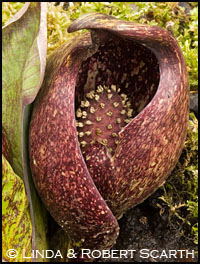introduction - galleries - technique - catalogue - notes - links - contact - blog - deep nature

Skunk Cabbage
Spring is in the air! Well, almost. Spring air can have a pungent, as well as a sweet smell. We write this while it minus 4 degrees but while we wait for the first harbinger of spring, the often stinky Skunk Cabbage (Symplodcarpus foetidus) to peek out of the seeps and tiny brook at nearby wetland. Sometimes we find spathes peeking out of the mud along the water?s edge or even under the snow in January, though it is usually March before wet woodland blooms with Skunk Cabbage.
As spring progresses, the Skunk Cabbage is joined by Marsh Marigold in the brook and little wetland. Then the woodland flowers (three species of Trillium, Toothwort, Violets, etc.) Skunk Cabbage spathes (a modified leaf) are usually maroon or wine colored but sometimes are mottled with green, tan and yellow spots or stripes. There is nothing ethereal or delicate about Skunk Cabbage (a member of the Arum family) like the white and pink May flowers that come later. Skunk Cabbage is sturdy appearing but easily crushed by a wayward step. Both the ?blossom? and the leaves live up to their name and give off a skunk-like odor, especially with a warm breeze.
The spadix (the jack if it were a Jack-in-the-Pulpit) is a marvelous construction that regulates the internal temperature and enables it to melt snow and grow in what we would call inclement weather. Researchers have measured the spadix? internal temperature at 20?C (68?F) when the ambient air temperature hovered around freezing. The spadix sits atop a sturdy stalk surrounded by the spathe. The actual flowers are tiny collections stamens and stuck into the spadix like cloves in an orange. The male and female blossom parts bloom in succession from top to bottom of the spadix.
Widespread but sometimes uncommon, Skunk Cabbages are found in many countries in the northern latitudes: northeastern North America, northeastern Asia, northern Europe and Japan. It goes by many names: Skunkweed, Meadow Cabbage, Polecat Weed, Bear's Leaf or Bear?s Root, Foetid Hellebore. The reference to bears is because other than being nibbled on by Wild Turkey?s, American Black Bears are among the few animals known to eat it. Grouse and slugs also sometimes partake. One study in Massachusetts found that mother bears eat great quantities of Skunk Cabbage in spring when the acorn crop has been small the previous autumn and though their milk has less fat because of the diet change, their cubs do not seem adversely affected. We have seen Wild Turkeys eating Skunk Cabbage and often find beak shaped bites out of the spathes and fresh turkey tracks in the mud.
Like many plants used in folk medicine, it can be toxic. Some people develop blisters from handling the lush bright green leaves that appear as the spadix and spathe retreat. Eating roots that have not been properly prepared can cause burning and swelling of the mouth and throat from the high levels of calcium oxalate (oxilates are found in most dark green vegetables in small quantities). It takes five weeks to dry sufficiently to loose the calcium oxalate. Not an emergency wild food for humans.
Knowing this we would rather photograph the gorgeous shapes, colors and patterns while standing in the cold water with the plants along the little banks. Because this is a fragile ecosystem we use long lenses and/or walk up the sandy bottom of the little brook to not disturb the wet soil (or get stuck in it). The plump twirly shapes, decorated with speckles and lines, are a curtain with an opening through which the oval lamp of pollen and warmth invites flies in to pollinate it. Soon the mottled shaft spears up beside it to unfurl into an upside down green can-can petticoat that dances in the dappled light cast by the trees as they leaf out. And the yellow Marsh Marigolds add their splashes of color to the scene. And the insects that visit the Marsh Marigolds are a bit more decorative.
Sometimes we wonder how Gerard Manley Hopkins missed including Skunk Cabbage among the dappled things in his poem ?Pied Beauty? along with trout, brindle cows, skies and the mottled landscapes.
Linda & Robert Scarth, 2007.
First published in NatureScape News, 2 (3), 6, 2007.
